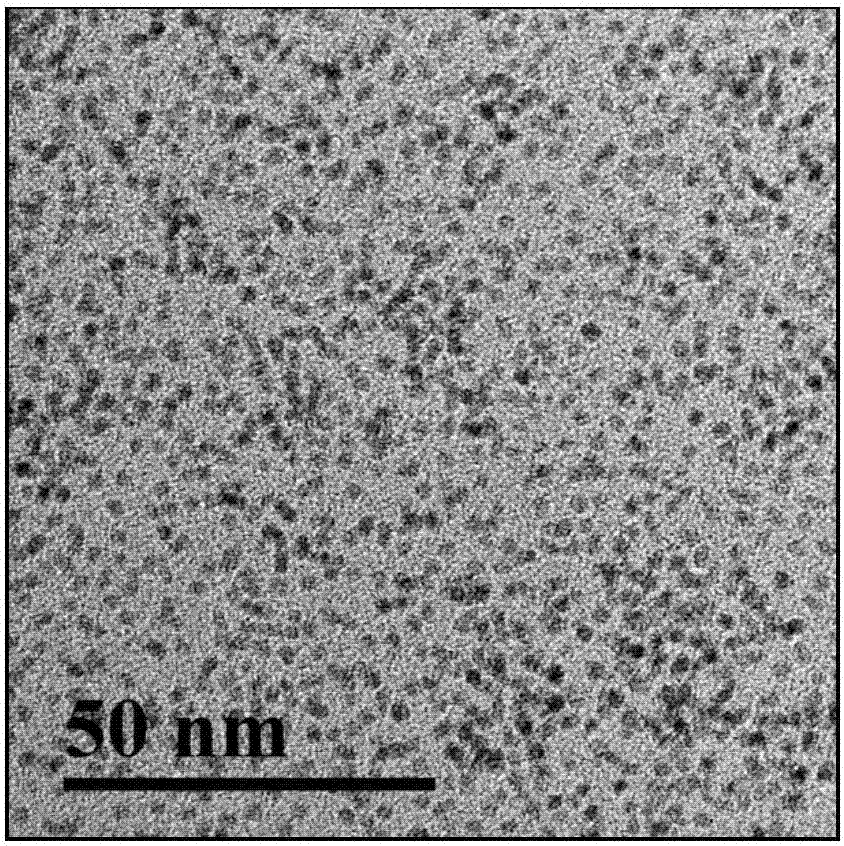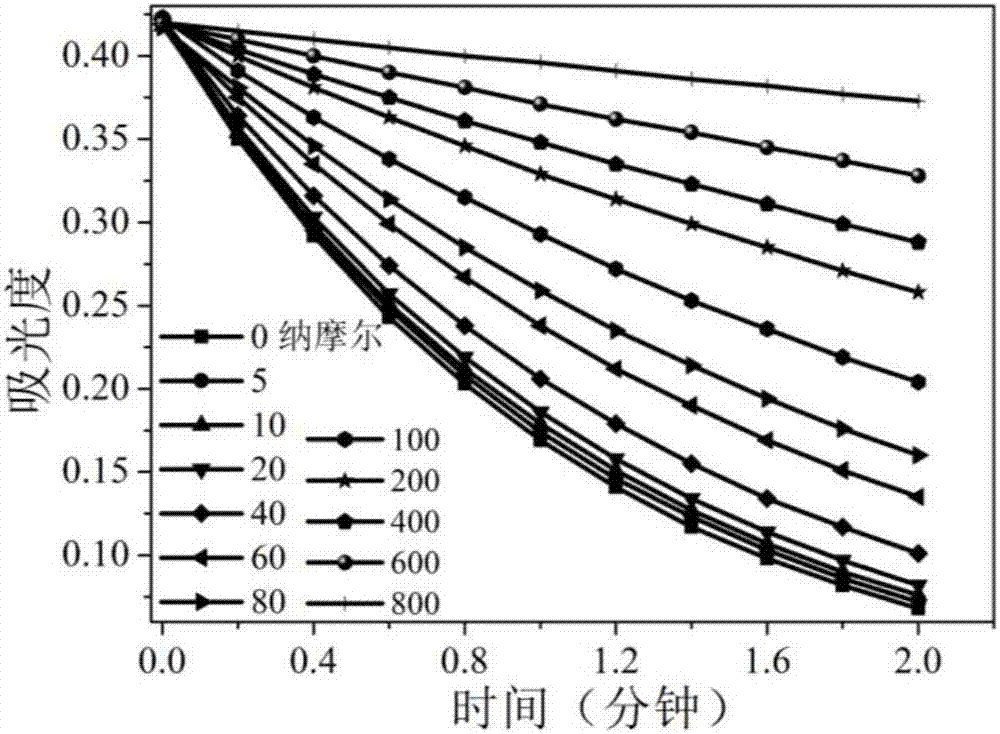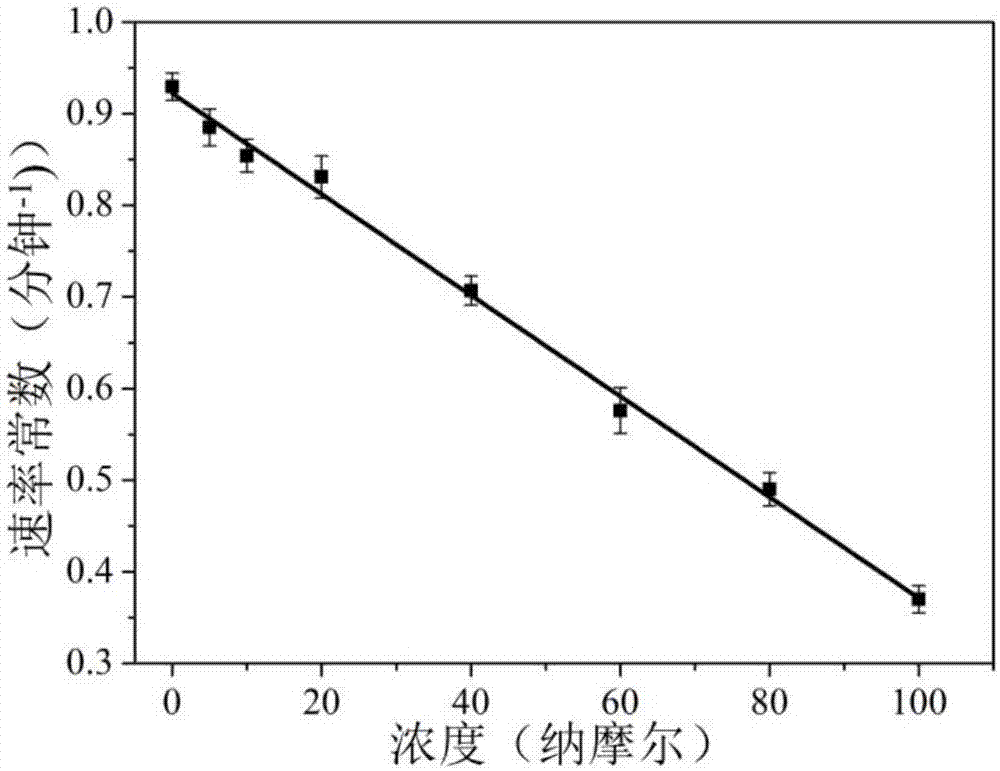Method for detecting hydrogen sulfide based on ruthenium nanoparticle colorimetric method
A nanoparticle, hydrogen sulfide technology, applied in the measurement of color/spectral properties, material analysis by observing the impact on chemical indicators, measuring devices, etc., can solve the problems of low sensitivity of hydrogen sulfide and inappropriate detection of trace hydrogen sulfide, etc. Achieve the effect of improving sensitivity, high accuracy and high sensitivity
- Summary
- Abstract
- Description
- Claims
- Application Information
AI Technical Summary
Problems solved by technology
Method used
Image
Examples
Embodiment 1
[0020] Press Ru 3+ : PVP monomer molar ratio is 1:10, respectively weigh 0.0123g RuCl 3 ·nH 2 O and 0.0555g PVP, under ultrasound, both are fully dissolved in 10mL ethylene glycol to form a polymer-protected ruthenium complex. The above mixed solution is poured into a 50mL round bottom flask, a stirring bar is added, and the solution is heated to 170°C and kept at this temperature for 6 hours, the solution turned from brownish red to brownish black, that is, the reaction was completed. Mix the original solution with the precipitating agent acetone at 1:3 and then centrifuge. After centrifuging at 8000 rpm for 5 minutes, take the precipitate and wash it with water. Repeatedly wash with acetone and deionized water for 3-5 times, and the obtained precipitate is dissolved in water to be a ruthenium nanoparticle water (Ru NPs) solution. At this time, the concentration of Ru NPs is calculated to be 26 μM. The obtained ruthenium nanoparticles are characterized by TEM and the resul...
Embodiment 2
[0022] The treated Ru NPs aqueous solution was diluted 32 times before the test, and the diluted concentration was 0.81 μM. And the wavelength position of the maximum absorbance of Orange I under alkaline conditions was measured at 512nm with an ultraviolet spectrophotometer in advance.
[0023] First, add 4 μL of 10 -2 M Orange I dye was added to a 2mL 0.8M hydrazine hydrate cuvette. At this time, the final concentration of Orange I was 0.02mM and the solution was alkaline, and the color of Orange I turned dark red. Then, 20 μL of different concentrations (0.5-80 μM) of Na 2 S was added to 10 μL 0.81 μM Ru NPs solution, and after the two were mixed evenly, the Ru NPs-Na 2 S mixed solution was immediately added to the cuvette. Finally, the UV-Vis spectrophotometer measured the degradation kinetics curve of Orange I at the maximum wavelength (512nm) in alkaline solution. All tests were performed at ambient temperature (21-26°C).
[0024] Such as figure 2 As shown, under ...
Embodiment 3
[0026] In order to accurately detect hydrogen sulfide, the relationship between the concentration of hydrogen sulfide and the reaction rate constant of each curve is calculated to obtain image 3 . The quantification curve showed a good linear relationship in the concentration range of 5.0-100nM and 100-800nM. The correlation coefficients of the curves are r=0.9923, n=8; r=0.9981, n=4, respectively. Based on the signal-to-noise ratio (S / N) = 3, the detection limit of this method for the determination of hydrogen sulfide is about 0.6 nM.
PUM
 Login to View More
Login to View More Abstract
Description
Claims
Application Information
 Login to View More
Login to View More - R&D
- Intellectual Property
- Life Sciences
- Materials
- Tech Scout
- Unparalleled Data Quality
- Higher Quality Content
- 60% Fewer Hallucinations
Browse by: Latest US Patents, China's latest patents, Technical Efficacy Thesaurus, Application Domain, Technology Topic, Popular Technical Reports.
© 2025 PatSnap. All rights reserved.Legal|Privacy policy|Modern Slavery Act Transparency Statement|Sitemap|About US| Contact US: help@patsnap.com



